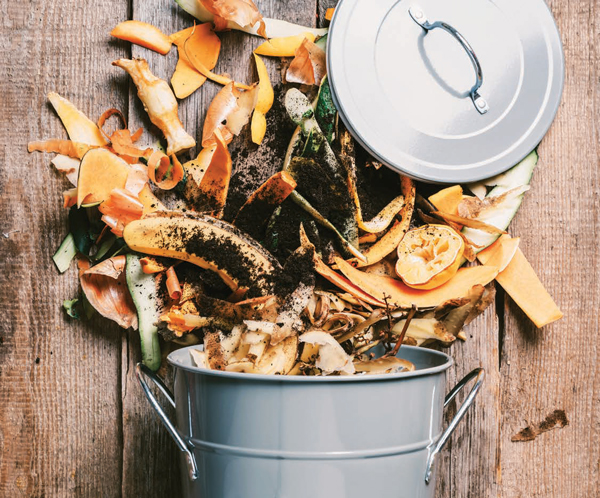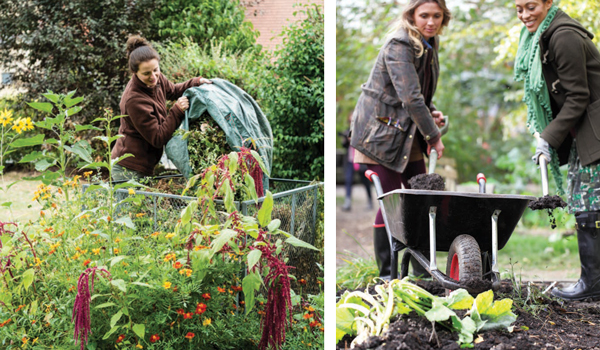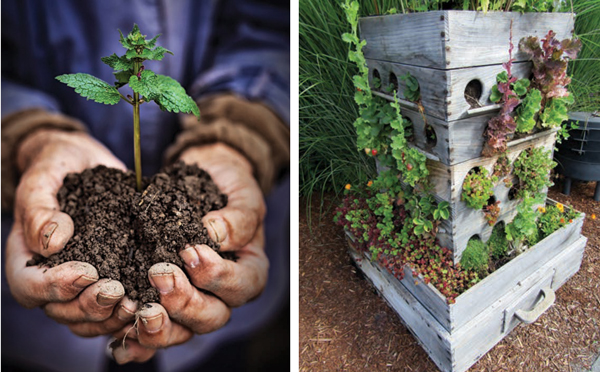Composting Is Cool | Turn Kitchen Scraps into Garden Gold
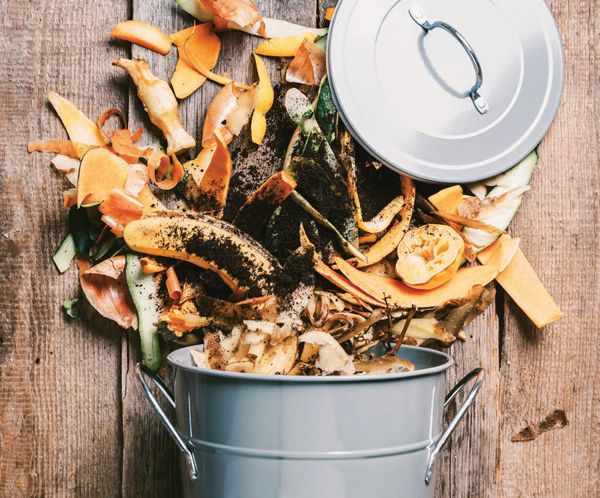
Black gold, chocolate cake mix, and liquid treasure all sound like something we should want—and as gardeners, we do, since they all describe “compost.” Gardeners use creative nicknames like these to lend importance to the ordinary.
 Kitchen scraps, sticks and twigs, and old potting soil and leaves take on a whole new worth when you start saving them instead of tossing them in the trash. Those plants you forgot to water before you went on vacation, the old salad greens and shriveled berries in the back of the fridge combined with yard debris make great fertilizer for your plants. Compost is the best ingredient you can add to your garden, and best of all, it is free. All you have to do is start the habit and you will be hooked.
Kitchen scraps, sticks and twigs, and old potting soil and leaves take on a whole new worth when you start saving them instead of tossing them in the trash. Those plants you forgot to water before you went on vacation, the old salad greens and shriveled berries in the back of the fridge combined with yard debris make great fertilizer for your plants. Compost is the best ingredient you can add to your garden, and best of all, it is free. All you have to do is start the habit and you will be hooked.
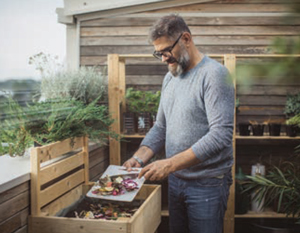 Avid composters know that composting is easy once you get your housemates on board. Unless you want to be pulling vegetable scraps put of the trash, everyone has to agree to one simple routine. Inside, you need a pail or plastic container with a lid. Everything that is a fruit or vegetable scrap goes in there as well as coffee grounds, used tea bags and eggshells. When it is full, dump it in your outside compost pile or bin.
Avid composters know that composting is easy once you get your housemates on board. Unless you want to be pulling vegetable scraps put of the trash, everyone has to agree to one simple routine. Inside, you need a pail or plastic container with a lid. Everything that is a fruit or vegetable scrap goes in there as well as coffee grounds, used tea bags and eggshells. When it is full, dump it in your outside compost pile or bin.
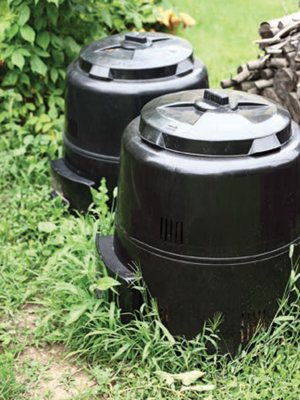 There are many variations on the basic method. For a pile, place it away from the house in a sunny spot of your yard. You can dig down a few inches to make a hollow place to pile up the scraps to contain the grass clippings, sticks and leaves you will add. To keep the smell down, and to make it tidy, many people choose to make or buy a compost bin. Garden centers and online retailers offer a variety of compost containers, or you may have the tools and supplies on hand to make one.
There are many variations on the basic method. For a pile, place it away from the house in a sunny spot of your yard. You can dig down a few inches to make a hollow place to pile up the scraps to contain the grass clippings, sticks and leaves you will add. To keep the smell down, and to make it tidy, many people choose to make or buy a compost bin. Garden centers and online retailers offer a variety of compost containers, or you may have the tools and supplies on hand to make one.
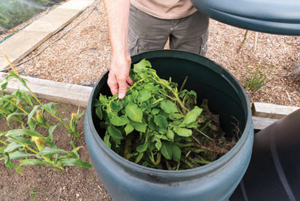 To construct your own, find a plastic bin or trash can with a tight-fitting lid. Drill holes in the bottom for drainage and on the sides for air. Making compost requires oxygen and accelerator. There are commercial products you can purchase to speed up the decomposition process, but many composters believe adding natural ingredients such as old potting soil creates the best recipe. Worms are wonderful for your compost bin. You can buy red worms from a garden store or dig some in your yard after a rain. Place them in the compost bin with your vegetable and other leftovers, and place it in a sunny spot in your yard; you’ll want it to get 4 to 5 hours or sun each day. The more sun the better, as the heat does part of the work for you. The bin should also be within reach of a hose so you can add water if it gets too dry.
To construct your own, find a plastic bin or trash can with a tight-fitting lid. Drill holes in the bottom for drainage and on the sides for air. Making compost requires oxygen and accelerator. There are commercial products you can purchase to speed up the decomposition process, but many composters believe adding natural ingredients such as old potting soil creates the best recipe. Worms are wonderful for your compost bin. You can buy red worms from a garden store or dig some in your yard after a rain. Place them in the compost bin with your vegetable and other leftovers, and place it in a sunny spot in your yard; you’ll want it to get 4 to 5 hours or sun each day. The more sun the better, as the heat does part of the work for you. The bin should also be within reach of a hose so you can add water if it gets too dry.
Compost needs to be turned every week to keep it decomposing; turning distributes the oxygen and bacteria that keep the internal temperature hot. A pitchfork works if you have a big pile; a shovel is good for a bin or you can buy the composters you turn with a hand crank to rotate the batch. Just remember the three no’s when choosing the compost bin over the trash receptacle: no dairy, no diseased plants, and no pet waste. Moldy fruits and vegetables are fine.
There are other recipes for homemade fertilizer that take less time to implement, or are good if you don’t have the outdoor space for composting but want that natural boost for your plants.
Banana peel water: Soak 2 to 3 banana skins in roughly 2 ½ cups of water for a few days. The minerals leach into the water, which creates a natural fertilizer for your plants. Don’t dilute. Pour directly on plants both inside and in the garden. The soaked peels can be tossed or added in your compost pile if you have one.
Compost tea: This easy-to-make fertilizer is an excellent source of nitrogen. Place 2 to 3 cups of compost (or old coffee grounds, tea bags and some old salad greens) in a pillow case or burlap sack. Put the bag in a large bucket with a lid and cover it with 10 to 15 cups of water. Let it sit for 7 to 14 days; then it is ready to use on your plants. You can dilute it 1 part compost tea to 16 parts water. Dump the compost back in your compost pile and start another brew.
Straight additives: Ground eggshells are good to sprinkle around peonies, basil, lettuce, strawberries, marigolds and cabbage. Adding ground eggshells to the hole when planting tomato plants gives them a boost of calcium and helps fight disease. Ferns, azaleas, gardenias, camellias, roses and lilies love the acidity of coffee grounds scattered around the base of the plant. Tea bags can be added near the roots of a plant to retain moisture and slowly release nutrients as the tea and the bag decompose.
The Bokashi method: If you want to be able to compost all—or almost all—kitchen waste, including meat or fish scraps, then you may be interested in the Bokashi method, which is gaining popularity. In this method, a cup of the Bokashi “bran” is added to a special accompanying bucket; this bran is an accelerator that relies on beneficial bacteria to break scraps down. Bonus: The bran makes this compost bin smell sweet, almost like fresh mulch. Like traditional composting methods, you place a full bucket outside in the sun. Within a few days, you’ll have two components in the bucket; a liquid natural fertilizer forms to be poured directly on your plants using the bucket’s spout device, and solids that remain can be added to your yard compost or used as mulch around the base of your plants.
Natural fertilizers are easy and simple. You always have the ingredients on hand and once it becomes a habit, it makes your kitchen even more functional. Composting conserves our landfills, and houseplants, trees and gardens benefit from this black gold. ✦
Banana peel water, Bokashi method, compost, Compost tea, Kitchen scraps, Leaves, old potting soil, old salad greens, shriveled berries, sticks, Straight additives, twigs, vegetable scraps
